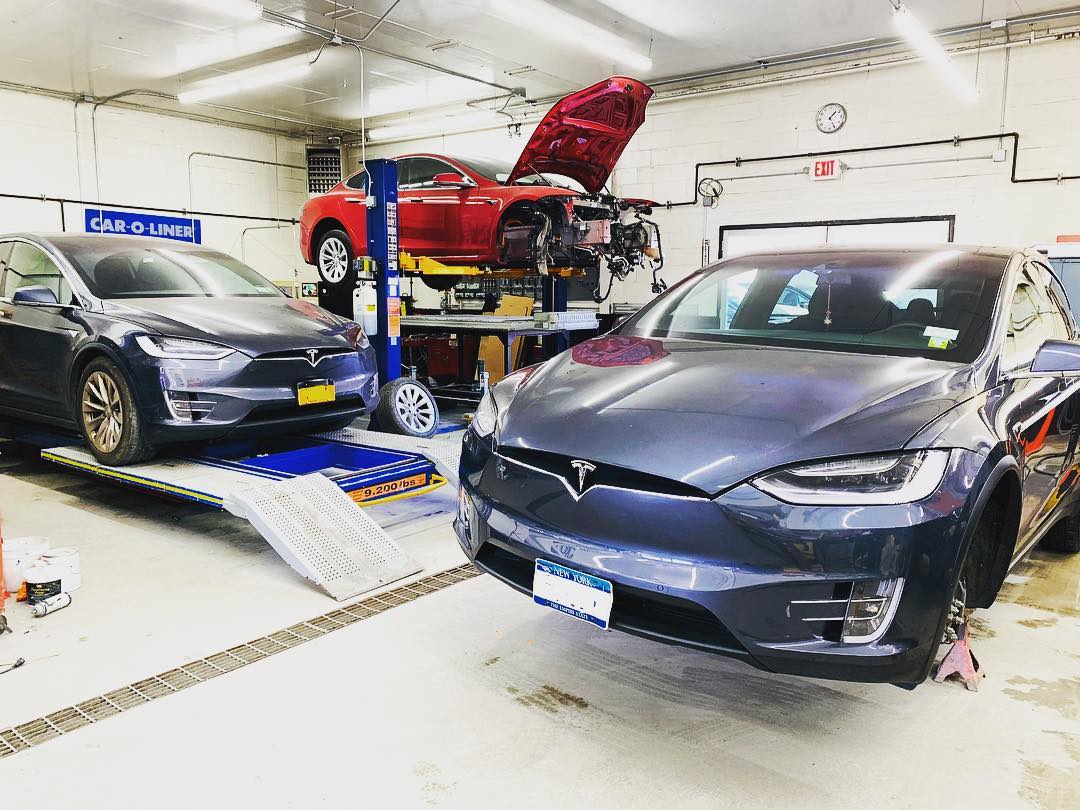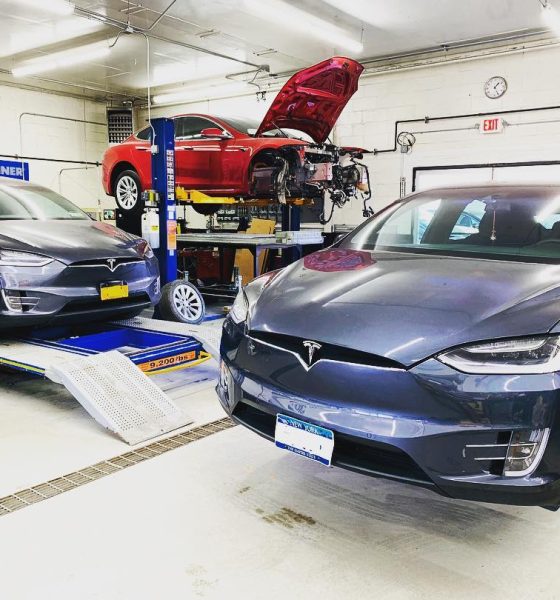

News
Tesla Australia shop debunks misconceptions about parts and repairs
Over the years, Teslas have garnered an unfortunate reputation for being a carmaker whose vehicle repairs are unreasonably expensive and whose parts availability is a nightmare. As per a Tesla repair shop in Australia, however, the electric vehicle maker’s repair costs and parts availability have reached parity with industry players.
As per Luxury Auto Body, a Tesla-certified repair shop in Melbourne, Teslas are actually not ridiculously expensive to repair. In comments to Drive, Danny, one of the shop’s panel beaters who has over 30 years of automotive experience, stated that with the exclusion of major outliers, Teslas typically cost about AU$4500 (US$3000) to AU$5000 (US$3300) per repair. In fact, some Tesla spare parts are actually very affordable.
“Some of the parts on Teslas are unbelievably cheap. Something like a bumper bar – those parts are cheap. When we talk about airbags and suspension, they’re (a bit pricier) but still considerably cheaper than a BMW or a Mercedes-Benz,” the panel beater noted.
Repairs, if needed, are much less costly than you thinkhttps://t.co/ntX7T9D0NR— Tesla Australia & New Zealand (@TeslaAUNZ) July 1, 2024
Interestingly enough, the auto repair veteran stated that front impacts on Teslas are significantly easier to repair than rear impacts. As per Drive, a vehicle with significant frontal impact in the shop costs about AU$25000 (US$16600) to repair even if it needs a new dash and both its airbags have deployed, but a Tesla that needs repairs in the rear could result in charges of about AUS45000 (US$30000). Despite this, the panel beater noted that similar repairs for a BMW or Mercedes-Benz vehicle would still be more expensive at about AU$50000 (US$33200) to AU$60000 (US$39800).
“If we talk about a rear impact, it’s definitely more involving because Teslas – depending on the model – are glued and riveted on when you’re replacing a quarter panel, for example. So they’d be more on par with repairing a BMW or a Mercedes. They’re pretty basic at the front, but the back is definitely more involving,” the panel beater said. He also noted that “a lot of the sensors and cameras can be calibrated in-house” so Teslas do not really pose any particular challenges compared to other vehicles.
Last year, Tesla Australia put some effort into supporting its customers by opening a sales, service, and delivery parts hub in Auckland with the goal of expediting the repairs of damaged vehicles. Tesla-certified repair shops also have access to the company’s electronic parts catalog, which includes all the necessary information needed to repair a Tesla. And while there are still wait times for some parts, the availability of spare parts for damaged Teslas has become generally good.
“The availability of parts and strike rate are really good, and there’s only been a couple of occasions where you have to wait for parts. On one occasion we had to wait six weeks,” Danny said. The panel beater also mentioned that so far,Tesla’s build quality has generally become comparable to mass market automakers. “Build quality is in line with a mass-produced car – not that that’s a bad thing. They’re a good all-rounder for everyday use,” he said.
Electric vehicle fires tend to spread like wildfire in the news, but the panel beater explained that so far, the shop has not experienced a single battery fire. This is quite impressive as the shop deals with damaged Teslas. “We haven’t had experience with (batteries catching fire). The way the cars come in, (even when) they’ve been in major collisions, there’s been no risk. With the Model Y, they’ve actually got a first responders’ wiring harness that (you can) cut for safety reasons… They go into a shutdown mode in the event of an accident,” he said.
Watch Drive’s video about Tesla repairs below.
Don’t hesitate to contact us with news tips. Just send a message to simon@teslarati.com to give us a heads up.

Elon Musk
Elon Musk’s X will start using a Tesla-like software update strategy
The initiative seems designed to accelerate updates to the social media platform, while maintaining maximum transparency.

Elon Musk’s social media platform X will adopt a Tesla-esque approach to software updates for its algorithm.
The initiative seems designed to accelerate updates to the social media platform, while maintaining maximum transparency.
X’s updates to its updates
As per Musk in a post on X, the social media company will be making a new algorithm to determine what organic and advertising posts are recommended to users. These updates would then be repeated every four weeks.
“We will make the new 𝕏 algorithm, including all code used to determine what organic and advertising posts are recommended to users, open source in 7 days. This will be repeated every 4 weeks, with comprehensive developer notes, to help you understand what changed,” Musk wrote in his post.
The initiative somewhat mirrors Tesla’s over-the-air update model, where vehicle software is regularly refined and pushed to users with detailed release notes. This should allow users to better understand the details of X’s every update and foster a healthy feedback loop for the social media platform.
xAI and X
X, formerly Twitter, has been acquired by Elon Musk’s artificial intelligence startup, xAI last year. Since then, xAI has seen a rapid rise in valuation. Following the company’s the company’s upsized $20 billion Series E funding round, estimates now suggest that xAI is worth tens about $230 to $235 billion. That’s several times larger than Tesla when Elon Musk received his controversial 2018 CEO Performance Award.
As per xAI, the Series E funding round attracted a diverse group of investors, including Valor Equity Partners, Stepstone Group, Fidelity Management & Research Company, Qatar Investment Authority, MGX, and Baron Capital Group, among others. Strategic partners NVIDIA and Cisco Investments also continued support for building the world’s largest GPU clusters.
News
Tesla FSD Supervised wins MotorTrend’s Best Driver Assistance Award
The decision marks a notable reversal for the publication from prior years, with judges citing major real-world improvements that pushed Tesla’s latest FSD software ahead of every competing ADAS system.

Tesla’s Full Self-Driving (Supervised) system has been named the best driver-assistance technology on the market, earning top honors at the 2026 MotorTrend Best Tech Awards.
The decision marks a notable reversal for the publication from prior years, with judges citing major real-world improvements that pushed Tesla’s latest FSD software ahead of every competing ADAS system. And it wasn’t even close.
MotorTrend reverses course
MotorTrend awarded Tesla FSD (Supervised) its 2026 Best Tech Driver Assistance title after extensive testing of the latest v14 software. The publication acknowledged that it had previously criticized earlier versions of FSD for erratic behavior and near-miss incidents, ultimately favoring rivals such as GM’s Super Cruise in earlier evaluations.
According to MotorTrend, the newest iteration of FSD resolved many of those shortcomings. Testers said v14 showed far smoother behavior in complex urban scenarios, including unprotected left turns, traffic circles, emergency vehicles, and dense city streets. While the system still requires constant driver supervision, judges concluded that no other advanced driver-assistance system currently matches its breadth of capability.
Unlike rival systems that rely on combinations of cameras, radar, lidar, and mapped highways, Tesla’s FSD operates using a camera-only approach and is capable of driving on city streets, rural roads, and freeways. MotorTrend stated that pure utility, the ability to handle nearly all road types, ultimately separated FSD from competitors like Ford BlueCruise, GM Super Cruise, and BMW’s Highway Assistant.
High cost and high capability
MotorTrend also addressed FSD’s pricing, which remains significantly higher than rival systems. Tesla currently charges $8,000 for a one-time purchase or $99 per month for a subscription, compared with far lower upfront and subscription costs from other automakers. The publication noted that the premium is justified given FSD’s unmatched scope and continuous software evolution.
Safety remained a central focus of the evaluation. While testers reported collision-free operation over thousands of miles, they noted ongoing concerns around FSD’s configurable driving modes, including options that allow aggressive driving and speeds beyond posted limits. MotorTrend emphasized that, like all Level 2 systems, FSD still depends on a fully attentive human driver at all times.
Despite those caveats, the publication concluded that Tesla’s rapid software progress fundamentally reshaped the competitive landscape. For drivers seeking the most capable hands-on driver-assistance system available today, MotorTrend concluded Tesla FSD (Supervised) now stands alone at the top.
News
Elon Musk’s Grokipedia surges to 5.6M articles, almost 79% of English Wikipedia
The explosive growth marks a major milestone for the AI-powered online encyclopedia, which was launched by Elon Musk’s xAI just months ago.

Elon Musk’s Grokipedia has grown to an impressive 5,615,201 articles as of today, closing in on 79% of the English Wikipedia’s current total of 7,119,376 articles.
The explosive growth marks a major milestone for the AI-powered online encyclopedia, which was launched by Elon Musk’s xAI just months ago. Needless to say, it would only be a matter of time before Grokipedia exceeds English Wikipedia in sheer volume.
Grokipedia’s rapid growth
xAI’s vision for Grokipedia emphasizes neutrality, while Grok’s reasoning capabilities allow for fast drafting and fact-checking. When Elon Musk announced the initiative in late September 2025, he noted that Grokipedia would be an improvement to Wikipedia because it would be designed to avoid bias.
At the time, Musk noted that Grokipedia “is a necessary step towards the xAI goal of understanding the Universe.”
Grokipedia was launched in late October, and while xAI was careful to list it only as Version 0.1 at the time, the online encyclopedia immediately earned praise. Wikipedia co-founder Larry Sanger highlighted the project’s innovative approach, noting how it leverages AI to fill knowledge gaps and enable rapid updates. Netizens also observed how Grokipedia tends to present articles in a more objective manner compared to Wikipedia, which is edited by humans.
Elon Musk’s ambitious plans
With 5,615,201 total articles, Grokipedia has now grown to almost 79% of English Wikipedia’s article base. This is incredibly quick, though Grokipedia remains text-only for now. xAI, for its part, has now updated the online encyclopedia’s iteration to v0.2.
Elon Musk has shared bold ideas for Grokipedia, including sending a record of the entire knowledge base to space as part of xAI’s mission to preserve and expand human understanding. At some point, Musk stated that Grokipedia will be renamed to Encyclopedia Galactica, and it will be sent to the cosmos.
“When Grokipedia is good enough (long way to go), we will change the name to Encyclopedia Galactica. It will be an open source distillation of all knowledge, including audio, images and video. Join xAI to help build the sci-fi version of the Library of Alexandria!” Musk wrote, adding in a later post that “Copies will be etched in stone and sent to the Moon, Mars and beyond. This time, it will not be lost.”








